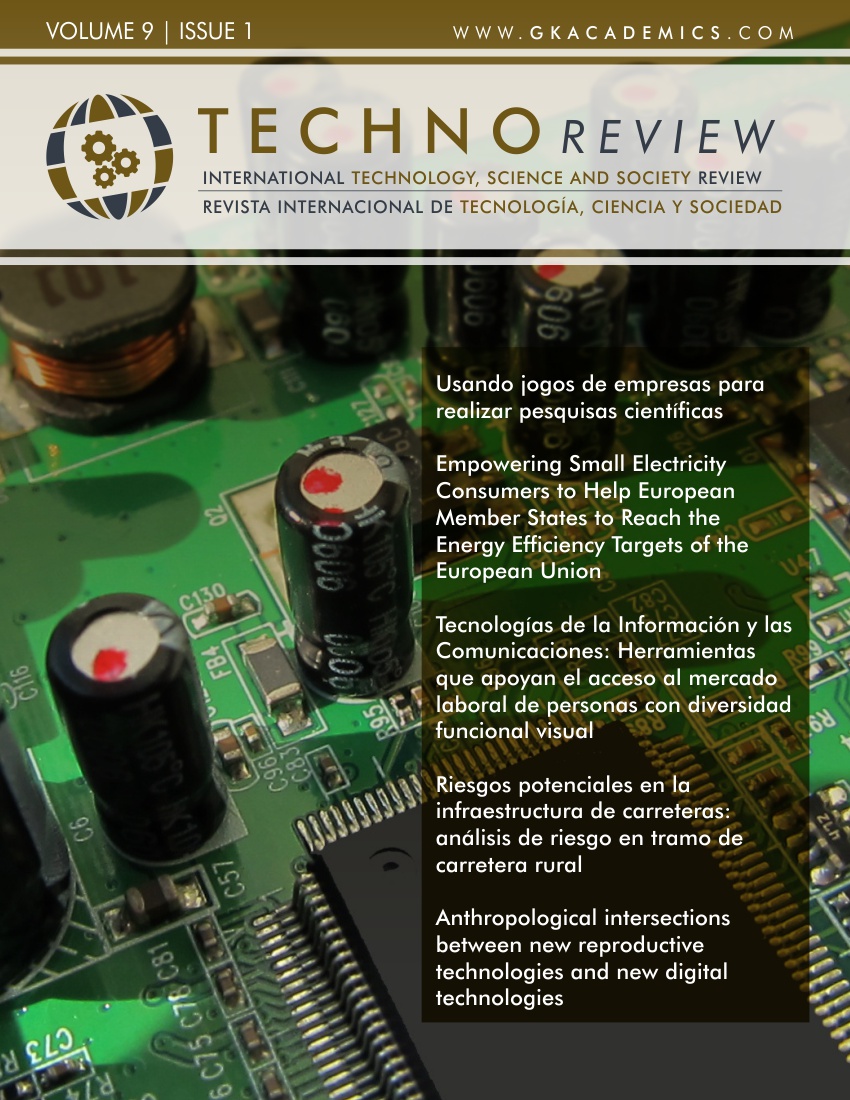Information and Communications Technology (ICT) Tools that Support Access to the Labor Market of People with Visual Functional Diversity
DOI:
https://doi.org/10.37467/gka-revtechno.v9.2147Keywords:
ICT, Labor Market, Visual Functional Diversity, STSAbstract
This manuscript is derived from an investigative exercise that forms part of the theoretical sustenance in the development of a master thesis, with the objective of evaluating the implementation of a governmental project oriented to train in the use and appropriation of technological tools by the population with visual functional diversity in Colombia. In this article, show various theoretical positions based since the science, technology and society studies, accessibility and functional diversity. Finally, a synthesis is made from the STS studies and the disability models.
References
Aristizabal lópez, A., y Ortiz-Clavijo, F. (2015). Uso y apropiación de las TICs en el ámbito de la educación superior orientadas al apoyo de estudiantes con discapacidad visual. In xviii Congreso Internacional EDUTEC. EDUTEC.
Berrío-Zapata, C., y Rojas, H. (2014). La brecha digital universitaria: Laapropiación de las TIC en estudiantes deeducación superior en Bogotá (Colombia). Revista Comunicar, XXI(43). Retrieved from http://www.redalyc.org/html/158/15831058015/
Bocconi, S., y Ott, M. (2013). ICT and Universal Access to Education: Towards a Culture of Accessibility (pp. 330–337). Springer, Berlin, Heidelberg. https://doi.org/10.1007/978-3-642-35879-1_39
Carabaza González, J. I. (2012). Apropiación de las tecnologías de la información y comunicación: apuntes para su operacionalización. Primas Social. Revista de Investigación Social, 352–390. Retrieved from http://www.isdfundacion.org/publicaciones/revista/numeros/9/secciones/abierta/01-apropiacion-tics.html
Ferreira, M. A. V, y Díaz Velázquez, E. (2009). Discapacidad, exclusión social y tecnologías de la información Disability, Social Exclusion and Information Technologies. Política y Sociedad, 46(2), 237–253. Retrieved from https://search.proquest.com/openview/63697fc3e02babb2d18100ea1320e1c9/1?pq-origsite=gscholar&cbl=55462
Fundación Vodafone España. (2013). Acceso y uso de las TIC por las personas con discapacidad. Madrid . Retrieved from http://www.aspaym.org/pdf/publicaciones/Acceso y uso de las TIC por las personas con discapacidad.pdf
Guenaga, M. L., Barbier, A., y Eguíluz, A. (2007). La accesibilidad y las tecnologías en la información y la comunicación. TRANS. Revista de Traductología, 11, 15. Retrieved from http://www.trans.uma.es/pdf/Trans_11/T.155-169BarbieryEguiluz.pdf
Hardoon, D. (2014). Riqueza: tenerlo todo y querer más (pp. 1–14). Oxford : Oxfam Internacional.
Jiménez Pizarro, C., y Toboso Martín, M. (2016, June 10). Ciencia, tecnología y diversidad: una perspectiva acerca de la educación inclusiva. Retrieved from http://www.oei.es/historico/divulgacioncientifica/?Ciencia-tecnologia-y-diversidad-una-perspectiva-acerca-de-la-educacion
Mijail, O., Martínez, T., Arianna, I., Pérez, H., Del Carmen, M., y Canino, R. (2011). La ceguera desde la perspectiva de los estudios de Ciencia-Tecnología- Sociedad. Humanidades Médicas, 11(3), 413–432. Retrieved from http://scielo.sld.cu/pdf/hmc/v11n3/hmc02311.pdf
MinTIC. (2017). ConVerTic. Retrieved October 10, 2017, from http://www.convertic.gov.co/641/w3-propertyvalue-15308.html
Montoya, R. S. (2006). TIC y discapacidad en América Latina y el Caribe. Retrieved from https://www.researchgate.net/profile/Rafael_Montoya/publication/28219980_TIC_y_discapacidad_en_America_Latina_y_el_Caribe/links/0deec5297182d84ea2000000/TIC-y-discapacidad-en-America-Latina-y-el-Caribe.pdf
Ortiz, L., Aristizabal, A., y Caraballo, F. (2016). Software de diagramado de UML: Definición de criterios de accesibilidad necesarios para la construcción de diagramas por usuarios con limitación visual. Actas de Ingeniería, 2, 334–351. Retrieved from http://fundacioniai.org//actas/Actas2/Actas2.39.pdf
Pablos, P. O. de., Zhao, J., y Tennyson, R. D. (2011). Technology enhanced learning for people with disabilities : approaches and applications. Information Science Reference.
Pallisera Díaz, M., y Rius Bonjoch, M. (2007). ¿Y después del trabajo, qué? Más allá de la integración laboral de las personas con discapacidad. Revista de Educación, 342, 329–348. Retrieved from http://sid.usal.es/idocs/F8/ART10309/pallisera.pdf
Parselis, M. (2016). El valor de las Tecnologías Entrañables. Revista Iberoamericana de Ciencia, Tecnología y Sociedad - CTS, (October), 71–83.
Pegalajar Palomino, M. del C. (2013). Tiflotecnología e inclusión educativa: evaluación de sus posibilidades didácticas para el alumnado con discapacidad visual. Revistad Electrónica de Investigación y Docencia, 9, 08-22. Retrieved from http://www.revistareid.net/revista/n9/REID9art1.pdf
Pereda, C., Ángel De Prada, M., y Actis, W. (2003). La inserción laboral de las personas con discapacidades. Barcelona: © Colectivo Ioé (Carlos Pereda, Miguel Ángel de Prada y Walter Actis) y Fundación ”la Caixa”. Retrieved from http://ibdigital.uib.es/greenstone/collect/portal_social/archives/flacai00/05.dir/flacai0005.pdf
Petz, A., y Miesenberger, K. (2010). Success through Exchange: The Higher Education Accessibility Guide (HEAG) (pp. 531–536). Springer, Berlin, Heidelberg. https://doi.org/10.1007/978-3-642-14097-6_85
Puin, D. C. (2002). Actitudes frente a la vinculación laboral de personas con discapacidad. Revista de La Facultad de Medicina , 50(4), 196–199. Retrieved from http://www.repositoriocdpd.net:8080/bitstream/handle/123456789/852/Art_PuinMDC_ActitudesVinculacionLaboral_2002.pdf?sequence=1
Quintanilla, M. A., Parselis, M., Sandrone, D., y Lawler, D. (2017). Tecnologías entrañables : ¿es posible un modelo alternativo de desarrollo tecnológico? Catarata.
Ribeiro, J., y Fuentes, S. S. (2013). Inclusión Educativa a través de las TIC. Indagatio Didactica, 5(4), 148–160. Retrieved from http://revistas.ua.pt/index.php/ID/article/view/2569/2436
Stendal, K. (2012). How do People with Disability Use and Experience Virtual Worlds and ICT: A Literature Review. Journal For Virtual Worlds Research, 5(1). https://doi.org/10.4101/JVWR.V5I1.6173
Toboso-Martín, M. (2008). Diversidad funcional, espacio de capacidades y diseño para todos. Madrid. Retrieved from http://digital.csic.es/handle/10261/23545
Toboso, M. (2011). Rethinking disability in Amartya Sen’s approach: ICT and equality of opportunity. Ethics and Information Technology, 13(2), 107–118. https://doi.org/10.1007/s10676-010-9254-2
Toboso, M., y Guzmán, F. (2009). Diversidad funcional: hacia la deconstrucción del cuerpo funcionalmente normativo. Retrieved from http://digital.csic.es/bitstream/10261/23424/1/MarioToboso-FranciscoGuzman_I-Congreso-SIEG-2009.pdf
Toboso Martín, M. (2008). Cultura científica y participación de las personas con discapacidad en materia de ciencia y tecnología. Biblioteca Nueva – OEI. Madrid, 237–252. Retrieved from http://digital.csic.es/bitstream/10261/55412/3/Mario Toboso_Cultura científica y participación.pdf
Villa Fernández, N., y Nuria. (2003). Situación laboral de las personas con discapacidad en España. Retrieved from http://www.repositoriocdpd.net:8080/handle/123456789/849
Yang, Y. (2016). Higher Education in China: Massification, Accessibility, and Quality Issues. In The Palgrave Handbook of Asia Pacific Higher Education (pp. 315–330). New York: Palgrave Macmillan US. https://doi.org/10.1057/978-1-137-48739-1_21
Downloads
Published
How to Cite
Issue
Section
License
Those authors who publish in this journal accept the following terms:
- Authors will keep the moral right of the work and they will transfer the commercial rights.
- After 1 year from publication, the work shall thereafter be open access online on our website, but will retain copyright.
- In the event that the authors wish to assign an Creative Commons (CC) license, they may request it by writing to publishing@eagora.org







